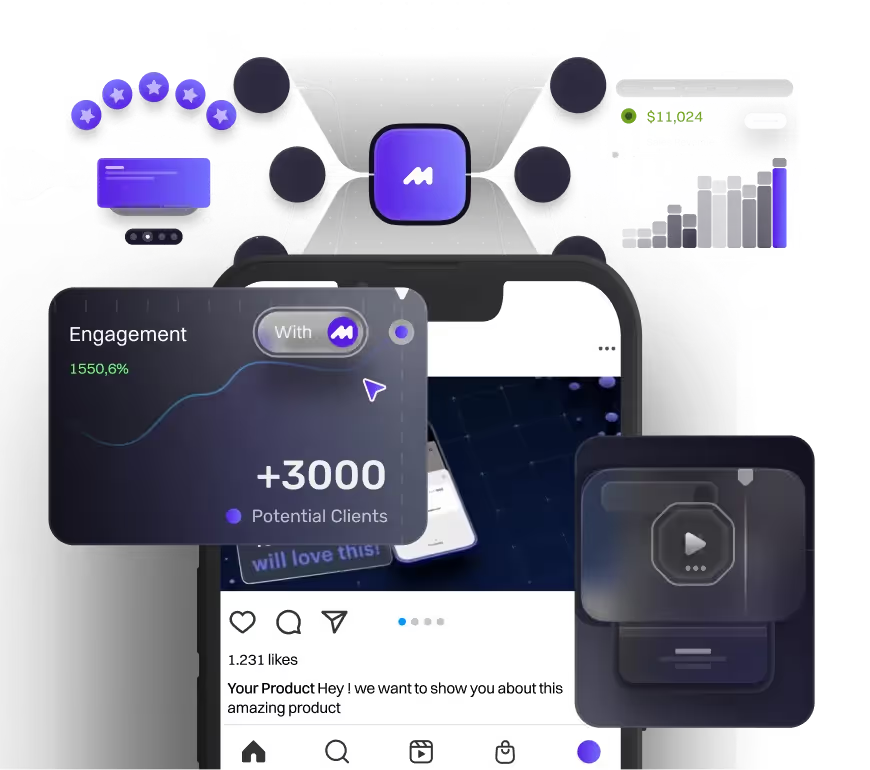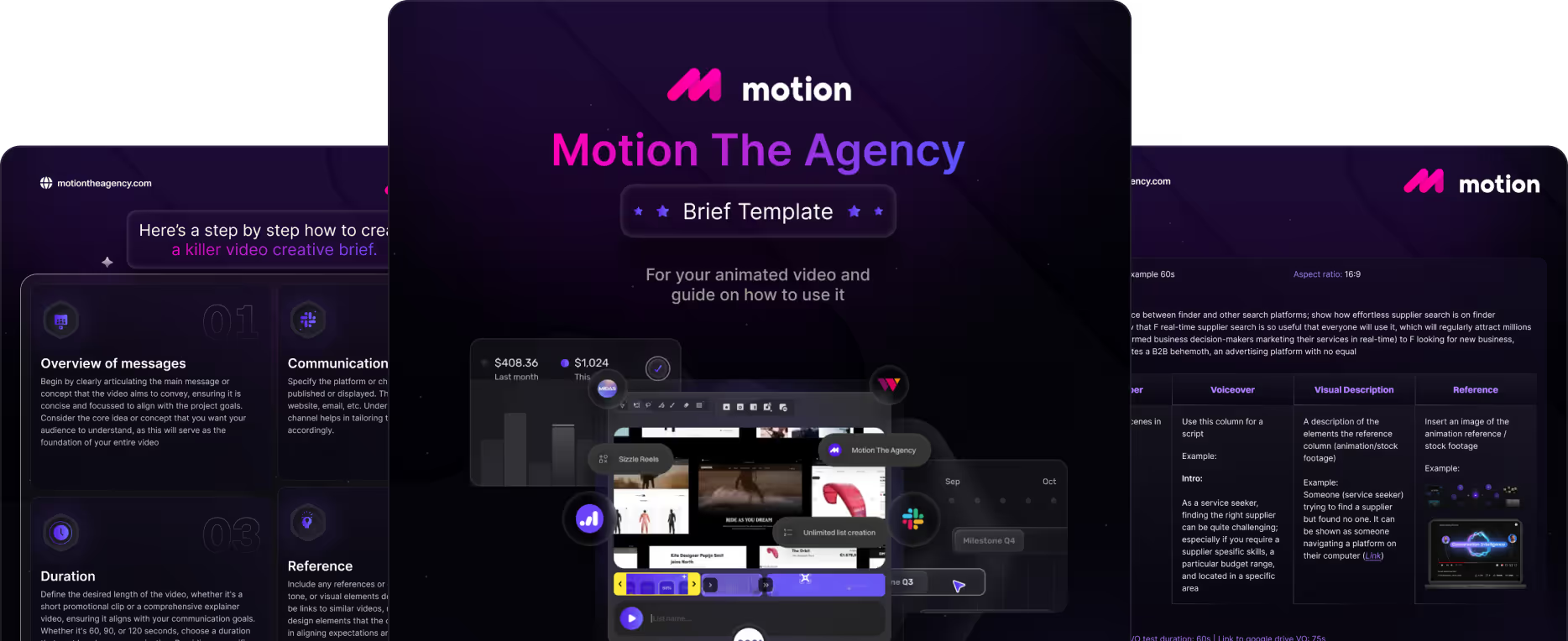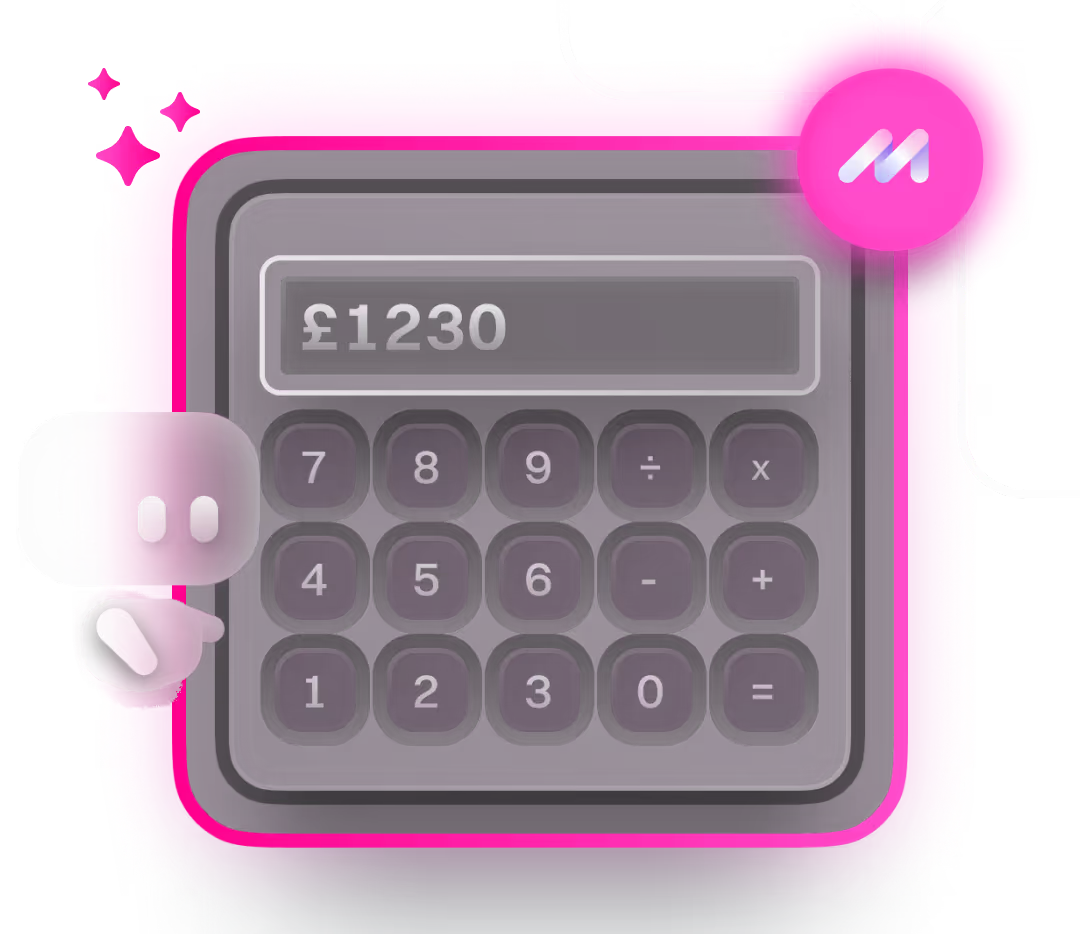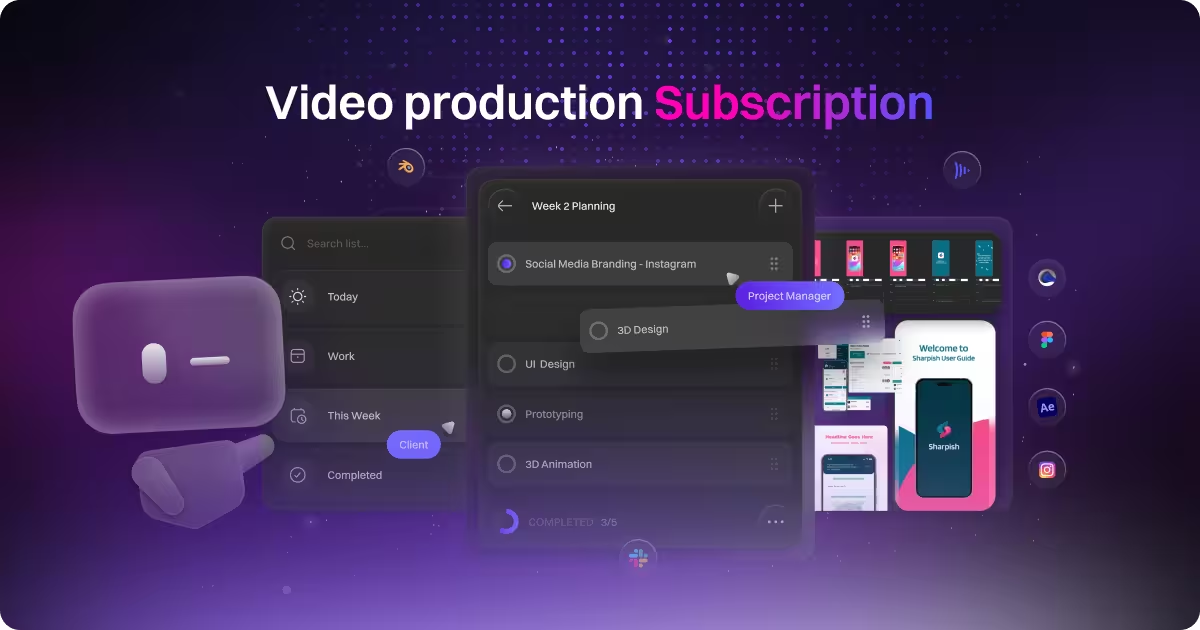3D Animation for Product Videos: Types, Techniques, and Real Examples


table of content
Alright, before we dive in, think back to any marketing video you’ve seen in the past few months. Odds are, at least one of them had some kind of 3D animation in it, even if it was subtle. And yeah, you’re not imagining it. 3D is everywhere right now.
And honestly, we get the hype. 3D animation makes it so much easier to show off ideas, products, or even complex processes in ways that just aren't possible with other styles or real-life footage. Plus, it just looks good. Clean, modern, and kind of timeless.
But while we were putting this piece together, we noticed something. The same styles and techniques kept popping up again and again. And weirdly, no one’s really broken them down properly. So that’s what we’re doing here. We’re walking through some of the most common styles and techniques used in 3D animation, with real examples and when you might want to use them.
That also brings up a couple of good questions. Why are these styles so popular? And which industries actually use them? That’s what we’ll be unpacking too.
Quick heads up. This isn’t a ranked list, and it doesn’t cover every single style out there. But it should give you a solid overview of what’s out there, what’s working, and why.
Let’s get into it.
3D Animation Video and Product
Okay, we talked about it briefly, but this article is really all about how companies use 3D animation in their content.
We’re focusing on the marketing side of things. How brands use 3D to show off products, explain features, and make their content more engaging. So we're not covering character animation or cinematic stuff like you'd see in movies or games. This is all about 3D in a business setting.
When we start a project, one of the first things we ask is whether the product is tangible or intangible. That’s just a simple way we use to categorize what we’re working with. Different agencies or even the clients themselves might use different terms, but this helps us keep things clear internally.
Tangible means anything physical you can actually touch, like a laptop, packaging, or hardware. Intangible covers things like software, platforms, or digital services. Once we know that, we can figure out how to bring it to life. Whether it needs to look realistic and detailed or clean and stylized, that early clarity helps us shape the direction right from the start.
Now, you might be wondering, why does it matter so much for us to understand the product before we even get into planning or ideation? The truth is, even though it's all 3D animation, different styles and video types require different prep. They might also lead to different timelines, tools, and price points. On top of that, every client and product comes with its own set of goals and expectations, so getting aligned early makes everything smoother down the line.
Type of 3D Animation Videos
Just a quick heads up before we go further. In motion design, or really any creative agency, certain terms can mean different things depending on who you’re talking to. The terms we’re using in this article are the ones we use internally with our team and in conversations with clients. They help us stay consistent. Other teams might use different names for the same ideas, and that’s totally normal.
With that said, we’ll include definitions and examples for every style and technique we mention here. Feel free to use this as a guide when you're figuring out which type of 3D animation fits best for your next big project.
Digital/CGI 3D
Have you ever watched a video that looks just the right amount of realistic, yet feels absolutely fantastical? You probably just saw a digital or CGI 3D animation. In general, digital/CGI 3D animation refers to standard CGI used across many industries. It brings realistic characters, objects, and environments to life in a fully 3D space.
At Motion The Agency, we haven’t explored this specific style of 3D animation yet, but we did feature it in our "10 Best 3D Animation Studios in 2025" article, where we recommended Haute CGI as a top choice for this type of work. This style is often used for both tangible and intangible products because it blends realism with imaginative visuals. That balance makes it easier to showcase intangible products in real-world settings without breaking the narrative or feeling out of place.
Used in:
- Films
- TV shows
- Video games
- Advertisements (tangible and intangible object)
Motion Graphics (3D)
Now this is one of the types of videos we pride ourselves on, and the video above is definitely a testament to that. We actually talked about the definition of motion graphics and motion design, and how they’re used by brands today, in our blog “Understanding Motion Graphics, Motion Design, and Animation for Modern Brands.”
In general, motion graphics can be described as clean, text-driven animations with UI elements, charts, or icons, all focused on clarity and sleek design. When you add 3D elements, it brings a more realistic and grounded feel, especially for tangible products. It lets us highlight parts of the product that might not be directly visible otherwise.
Used in:
- SaaS ads
- Branded content
- IT and Web3 related industry
Cutout Animation (3D-style)
Okay, the example we’re showing here might not be a recent promotional video, but it’s the easiest way to explain and showcase 3D cutout animation. In general, 3D cutout animation mimics flat paper cutouts arranged inside 3D space. It’s stylized, charming, and often playful. Due to the nature of the style, it tends to combine both 2D and 3D animation, making it feel more unique and engaging. One thing to note is that, in theory, this type of video could be used for an intangible product, but because of the blend between 2D and 3D aesthetics, people often use this style for tangible products instead.
Unfortunately for us, although we’ve played around with something similar in the past, we’re currently focused more on SaaS and IT companies, which rarely utilize this style. The video example above was actually created by Yeti Pictures, a production house based in Athens, Greece that specializes in more stylized and playful projects.
Used in:
- Playful brand videos
- Stylized campaigns
Mechanical Animation
Now this is a type of animation we can definitely handle at Motion The Agency. As long as we have access to CAD files or 3D references, we’re good to go. We've done similar work for product demos and internal explainers, especially for hardware or mechanical systems.
Mechanical or technical animation is all about precision. It focuses on showcasing how machines or technical systems work, often breaking down complex parts and movement in a clear, visual way. This style is specifically used for tangible products, since it relies on accurate representations of real-world objects. It’s perfect for showing how products function or are assembled, which makes it especially useful for industries where accuracy and clarity are critical.
Used in:
- Engineering demos
- Automotive content
- Industrial simulations
3D UI animation
This is a style we’re very familiar with at Motion The Agency. Since most of the clients that come to us are IT and SaaS companies, it’s no surprise that we end up creating a lot of this type of animation. We’ve used it across SaaS demos, product tours, and onboarding videos, where UI elements are brought to life inside a 3D environment for added depth and clarity.
3D UI animation involves showcasing product screens or user flows in a stylized 3D space, which is why this style is specifically for intangible products. It’s especially useful for making complex digital products easier to understand. By placing UI inside a 3D setting, it creates a more interesting and whimsical look that grabs attention while still making the product feel approachable and engaging.
We actually dissected and talked in more detail about how we use UI in 3D animation in our blog “3D Animation, VFX, and Motion Design”, where we did a brief case study on one of our past projects.
Used in:
- SaaS demos
- Product tours
- Onboarding videos
3D Product/ Explainer video
This is one of our bread and butter styles at Motion The Agency. 3D product and explainer videos are something we do regularly, especially for SaaS and IT companies looking to simplify big ideas and make their product easier to understand. This style works well for both tangible and intangible products — the only difference is that tangible products often require more creative assets like CAD files to accurately represent the object.
3D product explainer videos are fully animated in 3D and showcase how a product works, what it does, and why it matters. This type of animation lets us explain or show things that might be impossible or too complex to capture in real life, all while keeping the visuals clean, engaging, and brand-aligned.
Used in:
- Marketing videos
- Landing pages
- Product launches
Cel Shading
This isn’t a style we currently offer at Motion The Agency, so if you're looking to go this route, we'd recommend reaching out to a studio that specializes in it. That said, cel shading is a super cool look that's been big in the entertainment world, and honestly, we wouldn’t be surprised if it starts popping up more in the business space too.
Cel shading is a stylized 3D technique that mimics hand-drawn animation. It gives your video that flat, graphic, almost comic book vibe, using bold outlines and simplified colors. While it's not super common in corporate content yet, it's huge in animated series and stylized video games.
What makes it stand out is how it puts focus on your hero object — the main thing you want people to pay attention to. It’s a clever way to guide the viewer’s eye and keep the visuals interesting without going full realism.
Used in:
- Animated series
- Stylized video games
Popular Techniques in 3D animation product video
Alright, so this time we’re not talking about full videos. We’re focusing on specific sections inside the animation. These are key moments that keep showing up across different projects. It’s actually pretty interesting how often they appear. The frequency might vary depending on the industry, but the patterns are definitely there.
Just like we mentioned earlier, the same disclaimer still applies. Different teams might call these sections by other names, but we’re using the terms we usually use when chatting with our crew or clients.
Let’s get into it.
Exploded View
We actually mentioned of techniques in our 2D vs 3D Animation blog. But honestly we are quite sure this is a techniques that pretty much anyone has ever seen, just you don’t kno how to named them. It’s super common across different industries, especially when it comes to physical products with a lot of detail. If something’s not easy to spot at first glance, this method helps bring it to the surface, making it way easier to understand what sets that product apart.
It’s called the exploded view technique. Basically, it breaks the product into layers or parts to show how everything fits together, like a behind-the-scenes look at the build. You’ll usually spot it in product manuals, tech breakdowns, or launch videos. It’s great for highlighting components that might get overlooked and gives people a much clearer idea of how the whole thing works.
Cutaway 3D Animation/Cutaway render
This is another thing that we actually have done quite few, unfortunately most of this project is either currently in process on creation or, our client has yet time to release it. So we are going to show you an example of cutaway 3D animation techniques, from SPL Construction Youtube channel.
Interestingly enough, one of the industries that uses this technique the most is architecture. A cutaway render slices the product open to reveal what’s happening inside. It shows the internal components in a clean, stylized way, so everything still looks sharp and intentional. You’ll usually see this in tech devices, hardware showcases, or engineering demos where explaining how it works is just as important as showing what it is.
It’s similar to the exploded view technique and serves the same purpose. It helps people understand the inner workings of a product without physically taking it apart. This approach is a great way to show how the product functions internally without actually disassembling it, which might not even be possible in a live shoot. It gives you full control over the visuals while keeping things clear and easy to follow.
3D Simulation Effect
This one’s a little different. Simulation isn’t really a single animation style. It’s more like a layer you add to make things feel real and full of energy. Think fire, smoke, water, dust, or even a product breaking apart in slow motion. Instead of animating it all manually, simulations use physics to handle the motion, which makes things look way more natural and saves a ton of time.
We actually played around with this in our Copper project, where we recreated textures that felt like paper and sand. It gave the visuals a grounded, tactile feel while still keeping everything stylized and clean. Simulations like that are perfect when you want to mix realism with design. It makes the scene more engaging without overcomplicating things.
Why These Types and Techniques Works for Promotional Video for Corporate
Honestly, there’s no single answer to this. Every product has its own story and its own reason for needing a product video. That means there’s no one-size-fits-all when it comes to choosing animation types or techniques.
But over time, through conversations with our team and clients, we’ve noticed a few common themes. When we ask why they’re creating a product video and what they want to highlight in the animation, these are some of the answers that come up again and again.
And here they are:
- Clients often choose these types for their clean, sleek visuals that lead to easy-to-understand narrative, and quick turnaround time compare to other more advance types.
- Every great product video needs a polished hero moment — that's where the exploded view and cutaway render comes in. It’s basically your CTA magnet.
- Cutaway and exploded views are essential for showcasing product structure without using real-world prototypes, perfect for tech, hardware, and industrial sectors.
- Simulation adds realism and energy, whether it’s flowing water, friction in a device, or airflow in a smart product.
So, Which You Should Use
Most videos aren’t just one type. A lot of the time, it’s actually a mix of different animation styles depending on the project. It really comes down to what you’re trying to show and the kind of vibe you’re going for.
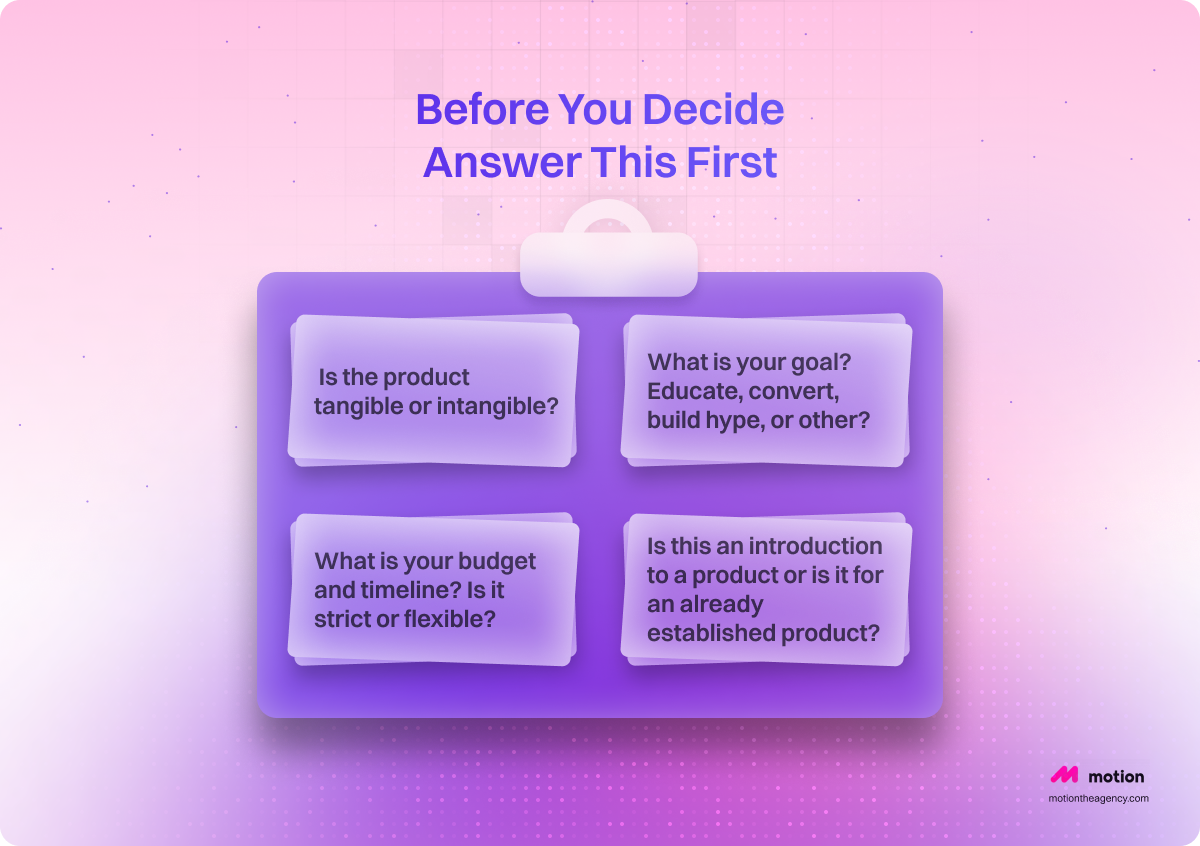
Figuring out what kind of video you need depends on a few things. Is your product something people can touch, or is it more of a service or experience? Do you want to show real people, characters, or just keep it simple and clean? Is the video about one clear subject, or is it meant to explain a bigger idea? And what’s the main goal? Are you trying to teach something, get people to take action, build some hype, or maybe all of that? These questions can help point you in the right direction, but that’s really just the starting point. You’ll still want to talk it through with your team and make sure it all lines up with your brand.
We made a cost calculator page to help you figure out what kind of video your company might need and make the whole process a lot easier. It also includes examples from our past projects, covering everything from tangible and intangible products to different styles, techniques, and video types like explainers, promos, and product demos.
Conclusion
Let’s be honest. Some products are just too complex, too detailed, or too unique for words and still images to explain properly. That’s where 3D animation comes in. It helps your audience see the full picture. It shows how a product works, what makes it different, and why it matters, all in a way that feels clear and engaging.
It’s especially useful for high-tech or feature-packed products. Animation brings motion, focus, and storytelling together to make complicated ideas easy to follow. It turns dry specs into something people can actually connect with.
But here’s the catch. A good-looking animation isn’t enough on its own. You need the right type for the right moment. What works on a landing page might fall flat on social. And a cool effect won’t do much if it doesn’t match your message or audience. Choosing the wrong style can waste time, budget, and momentum.
If you’re ready to create a product video that looks sharp and actually delivers results, we’ve got you. Book a call or check out our animated product video services to see what we can build together.

Contact Us
Ready to elevate your brand? Contact us for your
Free Custom Video Sample
